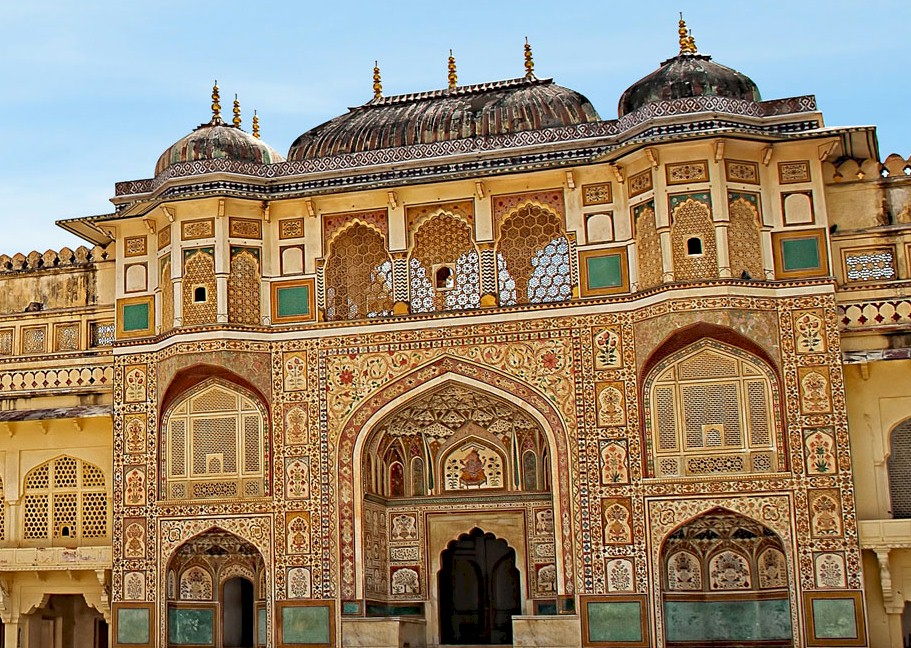JAIPUR
Jaipur, also known as 'the Pink City,' is the capital of Rajasthan in India.
Jaipur is the largest city in Rajasthan and was
built in the eighteenth century by Sawai Jai Singh
as India's first planned city. Although Jaipur
serves mainly as a stepping stone for travelers
heading to the desert cities of Jodhpur and
Jaisalmer, it is not without its own attractions,
such as several massive Rajput forts. So, despite
the chaos and dust, it is definitely worth pausing
here for several days. Now Jaipur is growing fast
and various development projects are being done by
the government & private enterprises.
To explore Jaipur you can also avail rajasthan tour packages.
Jaipur is often called the Pink City in reference to
its distinctly colored buildings, which were
originally painted this color to imitate the red
sandstone architecture of Mughal cities. The present
earthy red color originates from repainting of the
buildings undertaken for a visit by the Prince of
Wales in 1876.

Forts and Palaces of Jaipur
Amber Fort - This massive fort & palace complex built in Hindu-Muslim style dates back toMaharaja Mann Singh and was the royal palace of from 1600 to 1727. The name has nothing to do with the rather pretty pastel yellow colour of the palace, it was named after the town of Amber, in turn named after the goddess Amba. The main sights within the fort include the Sheesh Mahal, adorned with thousands on thousands of mirror tiles on the walls and ceiling. The fort/palace grounds are sprawling and have no signage whatsoever in any language, so it's worth getting an audio guide or a real guide. It's a bit of a hike up from the town, and the touristy thing to do is to hitch an elephant ride to the top. Rs. 10/50 Indians/foreigners, plus optional Rs.25/100 for still/video camera, Rs.100 for audio guide.
Jaigarh Fort - Never conquered in battle, this was considered the strongest of the three forts in the area. It is best known as the site of the world's largest cannon, the Jaivana, which wastest-fired only once — according to legend, despite using only the half the design amount of gunpowder, the cannonball flew 35 km! A better reason to visit the fort, though, are the scenic gardens at the other end and the spectacular views over the Amber Fort and the hills around. The remains of the foundry where the Jaivana (and many more) were cast are also in the fort grounds. Rs.50 plus Rs.40 for camera.
Nahargarh Fort - The smallest of the three forts, notable primarily for excellent views over Man Sagar lake and the vast sprawl of Jaipur. The fort also houses the (relatively) compact Madhavendra Bhawan palace, although its former splendour is fading fast under a new layer of graffiti and pigeon droppings. Portions of the movie Rang De Basanti were shot at this fort. To go the area where the "Pathshala" song was shot, take a left turn as soon as you enter the fort. Rs.10 entry, Rs.35 for Madhavendra Bhawan.
The City Palace - The City Palace is an imposing blend of traditional Rajput and Mughal architecture. It is a vast palace complex occupying nearly one-seventh of the Pink City. It was originally built by Maharaja Jai Singh II. The complex is divided into a series of courtyards, sprawling gardens and buildings. It is home to several palatial structures like the Chandra Mahal (home to present Maharajah of Jaipur), Mubarak Mahal (housing a textile museum), Diwan-e-Khas (or Hall of Private audience housing the two largest silver vessels in the world, which are duly mentioned in the Guinness book), the Diwan-e-Aam ( or Hall of Public Audience) and the gateway Ridhi Sidhi Pol (with four small doorways decorated with motifs depicting the four seasons). Another integral part of the palace complex is the Hawa Mahal, standing away from the main complex.
Jantar
Mantar - Jantar Mantar is the biggest of five
astronomical observatory build byMaharaja Jai Singh during
the period 1727-1734 in north India. It is located very
close to the City Palace. The observatory consists of
fourteen major geometric devices (or yantra in Hindi) for
measuring time, predicting eclipses, tracking stars in their
orbits, ascertaining the declinations of planets, and
determining the celestial altitudes etc. Unfortunately no
text is made available to tourists regarding the various
yantras nor are there any plaques/boards in front of them.
In most of the cases local guides are not of any help
either.